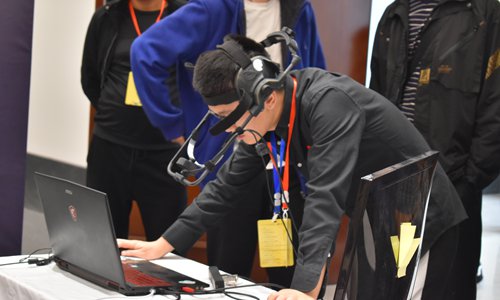HOME >> ARTS
Chinese animators chime in on the industry’s future after hit ‘Ne Zha’
By Chen Xi Source:Global Times Published: 2019/10/30 17:13:40

A visitor experiences virtual reality used in animation production at the Kaifeng International Cartoon and Animation Festival. Photo: Chen Xi/GT

The Red Classic comic art exhibition at the Kaifeng Museum Photo: Chen Xi/GT
It has been a landmark year for Chinese animation.
Ne Zha, the first Chinese-produced 3D animated feature, was hugely successful this summer. The film not only succeeded financially by earning 4.97 billion yuan ($704.7 million) to become the second-highest earning film in China, earlier this month it was also recognized critically when it was chosen as China's official entry for the International Feature Film Category at the 2020 Oscars.
"Chinese animation has undoubtedly taken a big step forward in recent years, and its influence is growing, which indicates that we are paying more attention to the discourse power of Chinese culture," Li Jianping, dean of the Beijing Film Academy's Animation School, said at the opening ceremony of the Kaifeng International Cartoon and Animation Festival in Kiafeng, Central China's Henan Province on October 22.
"The festival aims to provide a platform for experts and scholars in the field of animation to discuss the development of Chinese animation. We are trying to make the festival into the Oscars of animation in China and we hope it can gradually become more professional and international," Ni Na, deputy director of animation department of the Arts College at Henan University, told the Global Times on Sunday.
Turning to tradition
"Chinese culture is like a big ocean, we can find a lot of creative inspiration and material from it. I believe we could make excellent animated works if we deeply explore Chinese culture," Chen Jiaqi, a director at CCTV Animation, told the Global Times.
Chen noted that the East and West are growing increasingly similar culturally speaking, and many artists and creators are trying to find stories that can resonate with everyone in the world. For example, stories about truth, goodness and beauty are all tales that nations around the world continue to discuss. On the basis of this common ground, they can tell stories in their own way by adding Chinese elements, especially stories about people's livelihoods.
"I am creating an animation called Along the River During the Qingming Festival, which is named after the very well-known painting from Song Dynasty (960-1279) artist Zhang Zeduan. It tells some stories, including some historical events, related to the dynasty and conveys a message about human beings from the perspective of a boy and a girl. I hope children in the audience can learn something about Chinese history through this animation," Chen said.
"Chinese animation has a lot of room to grow commercially and when it comes to internationalization. The key thing is that storytelling should be internationalized and there needs to be constant creative innovation," Li said.
"China's animation and cultural and creative industries urgently need to explore China's various traditional cultures and resources. Presenting those cultures in animated form will benefit the development of the Chinese animation industry," said Liu Zhixin, deputy dean of the College of Creative Studies at the Shanghai Theater Academy.
He emphasized that whatever facet of Chinese culture is chosen, the film should be a complete story full of emotion.
"They need to have a plot, emotions and conflict. Otherwise, the animation will not capture the attention of audiences and end up failing," Liu said.
The next generation
According to Li, by combining the creativity of college talents and China's various ancient cultures the animation industry will be able to tap into unlimited potential.
"The rapid development of China's animation industry has brought us tremendous opportunities, but it also faces enormous challenges. It also requires teachers to explore students' professional vision, stimulate their innovative ability and strengthen the training of practical skills operation," said Lei Ting, deputy secretary of the Party Committee of Henan University.
"We cannot be too positive about the development of the Chinese animation industry just because of Ne Zha's high box office. We still have a lot to improve," said Wang Huaqiang, assistant production manager of Shanghai Animation Film Studios.
"We need to improve and strengthen the cultivation of excellent students majoring in animation and combine production, study and research. Outstanding students have the ability to get new inspiration by interacting with famed experts at production companies."
"Chinese animation should be based on the big picture, and our students in animation majors should have broad vision and international perspective, which will help domestic animation enter the world stage," said Huang Xiangdong, deputy dean of the Design School at the Xi'an Academy of Fine Arts.
Newspaper headline: Moving forward
Posted in: TV,CULTURE & LEISURE